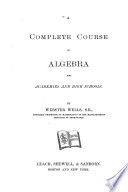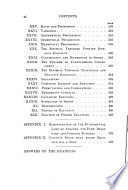 | Webster Wells - Algebra - 1879 - 468 pages
...proportion by DIVISION ; that is, the difference of the first two terms will be to the first term, as the difference of the last two terms is to the third term. Thus, if a : b = с : d then, ad = b с Subtracting both members from ac, ac — ad = ac —... | |
 | Webster Wells - Algebra - 1885 - 324 pages
...are in proportion by Division ; that is, the difference of the first two terms is to the first term, as the difference of the last two terms is to the third term. Let a : b = с : d. Then, ad = be. Subtracting both members from ac, ac — ad = ac — &e, or,... | |
 | Webster Wells - Algebra - 1885 - 370 pages
...are in proportion by Division; that is, the difference of the first two terms is to the first term, as the difference of the last two terms is to the third term. Let a : b = с : d. Then, ad = be. Subtracting both members from ac, ac — ad = ac — be, or,... | |
 | Webster Wells - 1885 - 368 pages
...are in proportion by Division; that is, the difference of the first two terms is to the first term, as the difference of the last two terms is to the third term Let a : b = с : d. Then, ad — be. Subtracting both members from ac, ac — ad = ac — bc,... | |
 | Webster Wells - Geometry - 1886 - 392 pages
...are in proportion by DIVISION ; that is, the difference of the first two terms is to the first term as the difference of the last two terms is to the third term. Let a:b = c:d, Then ad = be. Subtracting both members of the equation from ac, ac — ad = ac... | |
 | Webster Wells - Algebra - 1889 - 584 pages
...are in proportion by Division ; that is, the difference of the first two terms is to the first term, as the difference of the last two terms is to the third term, Let a : b = с : d. Then, ad = &c. Subtracting both members from ac, ac — ad = ac — be, or,... | |
 | Webster Wells - Algebra - 1890 - 560 pages
...terms are in proportion by Division; that is, the difference ofthefirnt two terms is to the first term as the difference of the last two terms is to the third term. Let a : b = c : d. Then, ad = bc. Subtracting both members from ac, ac — ad = ac — be, or,... | |
 | George William Jones - Algebra - 1892 - 300 pages
...proportion. THEOR. 6. In any proportion the difference of the first two terms is to the first term or the second as the difference of the last two terms is to the third term or the fourth. [division. COR. 1. The sum of 'the first two terms is to their difference as the... | |
 | Heinrich Borchert Lübsen - Algebra - 1897 - 364 pages
...of the sum or difference of the first two terms is to either the first or second term, as the sum or difference of the last two terms is to the third or fourth term. Expressed in symbols : a:b=c:d or 8:2=12:3 a-±-b : a=c-±-d : c ; 10 : 2=15 : 3 or a-±-b :... | |
 | Webster Wells - Algebra - 1897 - 434 pages
...are in proportion by Division; that is, the difference of the first two terms is to the first term as the difference of the last two terms is to the third term. Let the proportion be a : b = с : d. Then, ad — be. Subtracting each member of the equation... | |
| |